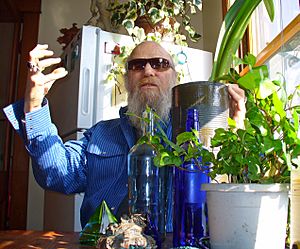Billy Name facts for kids
Quick facts for kids
Billy Name
|
|
|---|---|

Billy Name in 2007
|
|
| Born |
William George Linich
February 22, 1940 Poughkeepsie, New York, U.S.
|
| Died | July 18, 2016 (aged 76) |
| Known for |
|
William George Linich (born February 22, 1940 – died July 18, 2016) was an American artist known as Billy Name. He was a talented photographer, filmmaker, and lighting designer. Billy Name was a key person at The Factory, which was artist Andy Warhol's famous studio.
From 1964 to 1970, he was the main record-keeper, or archivist, at The Factory. His close friendship with Andy Warhol led to many creative projects together. Billy Name helped Warhol with his films, paintings, and sculptures. He became known as one of the "Warhol superstars".
Billy Name was famous for making Warhol's New York studio, The Factory, completely silver. He covered everything in silver foil and paint. He even lived there until 1970. His photos of The Factory and Andy Warhol are very important. They show us what the pop art era was like.
In 2001, the United States Postal Service used one of Billy Name's photos of Warhol. They put it on a special commemorative stamp. Billy Name also worked with artist Shepard Fairey. He provided a photo of Nico, a singer from the band Velvet Underground. Billy Name also took photos for the covers of Velvet Underground's albums White Light/White Heat and their third album. He also took pictures for the inside of The Velvet Underground and Nico.
Billy Name's Early Career
Billy Name got his unique name when he was filling out a form. He wrote "Billy" for his first name and "Name" for his last. That's how he became "Billy Name."
Before working with Andy Warhol, Billy Name designed lights for plays. He started this career in 1960. At the time, he was also working as a waiter at a dessert place called Serendipity 3.
He learned a lot from Nick Cernovich, a famous lighting designer. Cernovich had won an award for his lighting work. Billy Name helped design lights for the Spoleto Festival in 1960. He also designed lights for places like Judson Memorial Church and the Living Theater. He lit up performances for famous dancers like Lucinda Childs and Merce Cunningham.
Billy Name had a big impact on Andy Warhol's art. Warhol once said that Billy Name was very creative. He worked with lights, paper, and art supplies. Warhol learned a lot from him. Billy Name also played music in a group called Theatre of Eternal Music.
Working with Andy Warhol
Billy Name first met Andy Warhol at Serendipity 3. Later, they met again through a friend named Ray Johnson. Johnson brought Warhol to one of Billy Name's haircutting parties. Billy Name had covered his whole apartment in silver foil and paint. Warhol saw this and loved it.
Billy Name recalled that Warhol asked him to do the same thing for his new studio, The Factory. Billy Name agreed and started decorating it. He was skilled in lighting design from his theater work. He also installed all the lights and sound systems at The Factory.
In return for decorating his studio, Warhol gave Billy Name a new role. Billy Name said he wasn't a photographer before. But Warhol gave him a camera and told him to take still photos. Warhol wanted to focus on making films. So, Billy Name became the main photographer at The Factory. He also helped manage things there.
Billy Name eventually moved into The Factory. He lived in a small room at the back of the studio. Warhol gave him a 35mm camera and its instruction book. Billy Name taught himself how to take pictures. He even turned one of the bathrooms into a darkroom to develop his photos.
His skills in lighting and his creative ideas helped him capture the "silver years" of The Factory. These were the years from 1963 to 1970. Because he was so close to Warhol, Billy Name had a special view of The Factory. His photos show the main group of "superstars" who often performed for the camera.
Later Years
Billy Name lived in his hometown of Poughkeepsie, New York. He stayed there until he passed away in 2016.
In 1994, he created a short TV show called The Bunka Krunka Show. It was on a local cable channel. He worked with video editors Nicholas Apuzzo and Nick Stamper. Not many recordings of this show exist today.
Art Shows
- 2010: Les Rencontres d'Arles festival, France.

